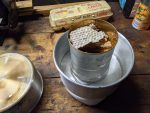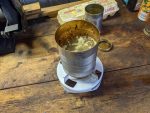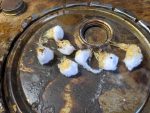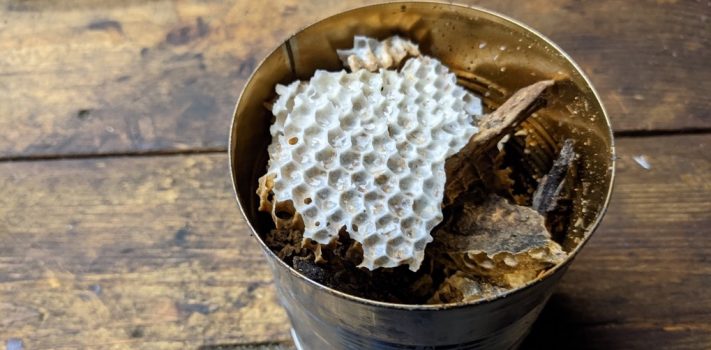The subtitle for this article is: Of Mice, Bees, Squirrels, and Beeswax
Of Mice
“. . . Mousie, you are not alone,
In proving foresight may be vain:
The best-laid schemes of Mice and Men,
Go oft awry,
And leave us naught but grief and pain,
For promised joy!”
(Excerpt from “To a Mouse, On Turning her up in her Nest, with the Plough, November 1785″ by Robert Burns, anglicized and updated by the Novice)
Of Bees
 Near my home is a large hollow tree that for many years has been the home to a large colony of bees. Each summer the bees busily collected nectar from flowers and made it into honey. Each winter they hunkered down snug in their hive and lived off of the honey that they had collected until spring. This past summer brought an end to the world as the bees knew it. A section of the hollow tree decayed to the point that it broke away. This loss left a large hole right at the base of the hive. As the first cold nights of autumn came, this hole allowed the frigid winds to enter the hive. The bees were unprepared for this, and quickly perished in the cold.
Near my home is a large hollow tree that for many years has been the home to a large colony of bees. Each summer the bees busily collected nectar from flowers and made it into honey. Each winter they hunkered down snug in their hive and lived off of the honey that they had collected until spring. This past summer brought an end to the world as the bees knew it. A section of the hollow tree decayed to the point that it broke away. This loss left a large hole right at the base of the hive. As the first cold nights of autumn came, this hole allowed the frigid winds to enter the hive. The bees were unprepared for this, and quickly perished in the cold.
Of Squirrels
The local squirrels soon noticed that a hoard of honey was unguarded. A large-scale squirrel invasion ensued. Day by day, a procession of squirrels made their way into and out of the hive. Our beagle, Tucker, did his best to drive off the invaders, but without success. As a result, the squirrels in our woods were unusually fat for a time.
The bees planned to provide for themselves, but they ended up feeding the squirrels.
Lessons from the Bees
May we all learn from the bees:
1. The End is Coming. The world as we know it will not endure. The end may be personal, with the loss of a job, an illness, or some other life-disrupting event. The end may be nation-wide or even global, with war, famine, pestilence, or some other major event turning things on their head. But one way or another, the end is coming.
2. It is Good to be Prepared. Every summer the bees had opportunity to say, “Life is good. Let’s sit back and enjoy it.” Instead, they prepared for coming hardship. For many winters, their preparations sustained them through the tough times.
3. The Most Important Thing to be Prepared for is Death. No matter how wise and thorough our preparations, death comes to all of us sooner or later. Jesus tells us not to lay up our treasures on earth where they may be lost, but rather to lay them up in heaven where they are safe for all of eternity. This does not mean that we should not prepare for the trials of life. But it does mean that the things that we treasure the most should be eternal. May we each find eternal life through faith in Jesus Christ. May we each seek to bring glory and honor to His name. May we each point other people toward His eternal kingdom.
Of Beeswax
 The bees left behind a valuable commodity that I should have put to good use: beeswax. By the time I realized this, most of this opportunity had slipped through my fingers. I did my best to salvage what I could by sorting through the refuse at the base of the tree to find whatever scraps of beeswax remained. I put these scraps in a tin can that had formerly held stewed tomatoes and headed for the barn. In the barn I topped off the fuel in my alcohol stove and fired it up. I put about a half inch of water in the bottom of a pot, put a coil of wire in the pot, put the tin can on the coil of wire, and put the pot on the stove. I then covered the pot and can with a larger pot to help hold in the heat.
The bees left behind a valuable commodity that I should have put to good use: beeswax. By the time I realized this, most of this opportunity had slipped through my fingers. I did my best to salvage what I could by sorting through the refuse at the base of the tree to find whatever scraps of beeswax remained. I put these scraps in a tin can that had formerly held stewed tomatoes and headed for the barn. In the barn I topped off the fuel in my alcohol stove and fired it up. I put about a half inch of water in the bottom of a pot, put a coil of wire in the pot, put the tin can on the coil of wire, and put the pot on the stove. I then covered the pot and can with a larger pot to help hold in the heat.
“Anticipation”
 One drawback of the alcohol stove is that it heats very slowly. It reminds me of the old Heinz ketchup ads from the late 1970s with the Carly Simon song, “Anticipation”. The stove just keeps me waiting. It took so long, that I resolved to order one of those ultralight camp stoves that use twigs as fuel. In the meantime, I sharpened knives: the Coast FX350 that I keep in the barn as well as the Leatherman Skeletool and the Swiss Army Classic SD that I keep in my pocket.
One drawback of the alcohol stove is that it heats very slowly. It reminds me of the old Heinz ketchup ads from the late 1970s with the Carly Simon song, “Anticipation”. The stove just keeps me waiting. It took so long, that I resolved to order one of those ultralight camp stoves that use twigs as fuel. In the meantime, I sharpened knives: the Coast FX350 that I keep in the barn as well as the Leatherman Skeletool and the Swiss Army Classic SD that I keep in my pocket.
 After about 15 minutes, the alcohol stove began to warm up and to burn more vigorously. Five minutes later the water was boiling well, and the wax was beginning to show signs of softening. After another five minutes, the wax had melted down to the point that I was able to add the last scraps of wax that would not previously fit in the can. At this point, I noticed that I was getting creosote from my gloves on the pots. I changed into a pair of gloves that I had not previously used while stoking the wood boiler. I then found a piece of steel wool, and cleaned off the outside of the pots while I was waiting.
After about 15 minutes, the alcohol stove began to warm up and to burn more vigorously. Five minutes later the water was boiling well, and the wax was beginning to show signs of softening. After another five minutes, the wax had melted down to the point that I was able to add the last scraps of wax that would not previously fit in the can. At this point, I noticed that I was getting creosote from my gloves on the pots. I changed into a pair of gloves that I had not previously used while stoking the wood boiler. I then found a piece of steel wool, and cleaned off the outside of the pots while I was waiting.
There were quite a number of bits of wood mixed in with the beeswax. I noticed that instead of melting away from the wood, the beeswax was soaking into the wood. This greatly reduced the yield of wax that I had available for my project. If I attempt to salvage beeswax again in the future, I will separate as much debris as possible from the wax before heating.
Before the wax could begin to pool in the bottom of the can, the pot came close to boiling dry, so I needed to add more water. Bringing the water to a boil again added another 15 minutes to the process. Finally, about an hour after I began the process, there were signs of wax beginning to pool at the bottom of the can.

 After another five minutes of melting, I took long-handled, needle-nose pliers and used them to dip the bottom of a cotton ball into the pool of wax. Over the course of the next ten minutes, I repeated this process a total of 15 times. After one of the balls had the opportunity to cool, I ignited it with a plasma lighter. It then burned for more than four minutes.
After another five minutes of melting, I took long-handled, needle-nose pliers and used them to dip the bottom of a cotton ball into the pool of wax. Over the course of the next ten minutes, I repeated this process a total of 15 times. After one of the balls had the opportunity to cool, I ignited it with a plasma lighter. It then burned for more than four minutes.
More Beeswax
Four days later I hit upon a plan to recover additional beeswax from the wax-soaked wood. I filled the can of wax-soaked wood about 2/3 full of water, and put the can on the alcohol stove to heat. Beeswax is lighter than water. As it melted in the warming water, it floated to the top. I spooned it off the top and put it into an empty olive can to cool and dry.
While I was waiting for the beeswax to cool and dry, I took an old emergency candle that had melted while stored in a box of camping gear. I put the ruined emergency candle in a can, placed the can on the wire coil in the pot of water, and returned the pot to the heat. When the ruined candle melted, it provided enough wax to treat seven cotton balls. After the paraffin balls had cooled, I lit one of them with a plasma lighter to see how effective it was as a fire starter. It burned for just under five minutes.
In the meantime, the beeswax had hardened in the olive can. I poured off the excess water, put the olive can in the hot water on the alcohol stove, and melted the beeswax. I was able to make eight more beeswax balls with the salvaged wax.
After the beeswax balls hardened, I attempted to light one for testing. I was unable to do so. The cotton had absorbed enough residual water to make it burn poorly. I let the remaining balls dry for a couple of days and tried again. It still would not burn well. After several more days of drying, I tried again. The cotton was just barely dry enough to create a flame sufficient to ignite the beeswax. Once the beeswax was lit, it burned brightly for more than five minutes.
Conclusions
If you have the opportunity to get some beeswax, it works great as tinder with a cotton ball. Try to separate as many impurities from the wax as you can before melting, since these impurities will tend to absorb wax during the melting process.
You can also boil materials containing beeswax in water, and let the melted wax float to the surface to be recovered. If you do this, you will need to allow a considerable period of time for the residual moisture to evaporate after separating the wax.
Disclaimer
I did not receive any financial or other inducements to mention any vendor, product, or service in this article.










